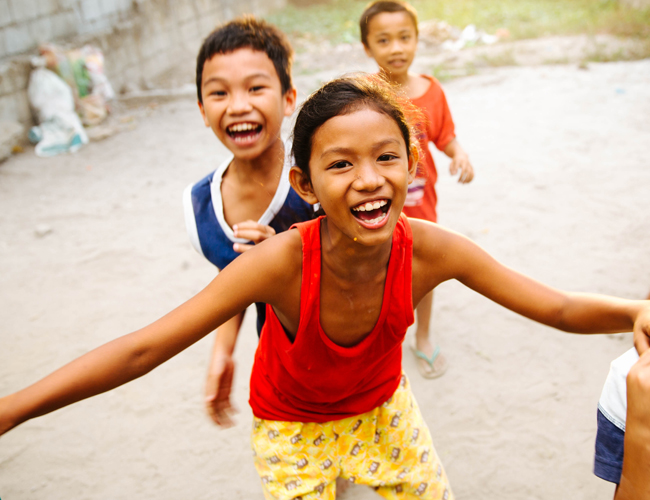Did You Know?

Mark truth and reconciliation on Sept. 30
September 25, 2023The National Day for Truth and Reconciliation (also known as Orange Shirt Day) is a Canadian statutory holiday marked every Sept. 30. The commemoration is an act of reconciliation to acknowledge the harm done to First Peoples.
The day is an important reminder of the need to recognize the strength and resistance of those who lived through and survived the violence of the residential school and colonial systems — and to reflect on our continuing impact on the lives of Indigenous peoples. For more information on Orange Shirt Day and to learn how you might become involved, go here.
For more information about fighting racism, see Vol. 15, No. 3 of the Children’s Mental Health Research Quarterly.

Childhood interventions can reduce racism
September 18, 2023A systematic review by the Children’s Health Policy Centre found two childhood interventions that appear to reduce racist attitudes. Pro-refugee books, alone and when paired with classification skills training, increase positive attitudes toward refugees. As well, history lessons led to improved attitudes toward Black people and to the increased valuing of racial fairness. Notably, both interventions were relatively brief — only two hours duration. Interventions that had no impact included pro-diversity TV programming, diversity workshops and classification skills training (when delivered alone). No interventions were successful in changing children’s responses to hypothetical scenarios, and no studies assessed actual behaviours. As well, the review found no assessments of interventions that focused on reducing anti-Indigenous racism. This work is greatly needed.
Still, these results offer an important starting point. Given the success of pro-refugee books, parents, teachers, librarians and practitioners may want to invest in antiracism
reading materials with relevance for the current Canadian context. To this end, the Canadian Children’s Book Centre provides a reading list for tackling racism. As well,
the American Academy of Pediatrics and UNICEF provide helpful antiracism guidelines and resources — suitable for differing development stages from the early years to the
teens. Similarly, the Canadian Paediatric Society offers antiracism resources for child and youth health care providers. Finally, given that teaching history has proven benefits, a recent publication aimed at adults, which could be used with youth, provides helpful information on the history of racism in BC.
For more information, see Vol. 15, No. 3 of the Children’s Mental Health Research Quarterly.

Teachers play an important role in respecting diversity
September 11, 2023Researchers have identified how teacher feedback can affect children’s acceptance of migrant peers. They conducted a study with nearly 1,000 students in Grades 3 to 6 in Germany, Austria and Switzerland. First, students saw photos of children they did not know on a computer screen and were asked to rate how much they would like to sit beside them. The photos included both migrant and non-migrant children. Then students were told that teachers often praised the children on the screen for being attentive or, alternatively, often scolded them for being inattentive. Teacher feedback significantly influenced students’ stated willingness to sit beside migrant children, with positive comments increasing this willingness and negative comments decreasing it. These results suggest that teachers can play an important role in changing children’s attitudes and helping them to appreciate diversity. For more information, see Vol. 15, No. 3 of the Children’s Mental Health Research Quarterly.

Mark FASD awareness and suicide prevention in September
September 4, 2023Two preventable health concerns are marked by back-to-back special days in September.
Sept. 9 is international Fetal Alcohol Spectrum Disorder (FASD) Awareness Day. In fact, September itself is an Awareness month in Canada for the condition — which is created by prenatal alcohol exposure, affecting brain and body development in utero. FASD is considered the leading cause of preventable developmental disabilities in Canada. While there is no cure, services and supports play an important role in preventing it. Not drinking alcohol, in any amount and at any point during or when planning a pregnancy, is the only way to fully prevent it. For more information, see Vol. 5, No. 2 of the Children’s Mental Health Research Quarterly.
Then, Sept. 10, marks World Suicide Prevention Day. Suicide is the second leading cause of death in Canada, behind only unintentional injuries, for 15- to 19-year-olds, and the third leading cause for 10- to 14-year-olds. Researchers have also documented differing patterns in Canadian youth suicide rates over time, by gender. Between 2000 and 2018, the suicide rate for boys between 10 and 19 years declined slightly. But the comparable suicide rate for girls showed a statistically significant increase of 0.09 deaths per 100,000. Suicide, of course has a devastating impact on families. For more information, see Vol. 16, No. 4 and Vol. 17, No. 1 of the Children’s Mental Health Research Quarterly.

International Overdose Awareness Day is Aug. 31
August 28, 2023International Overdose Awareness Day is the world’s largest annual campaign to end overdose, remember without stigma those who have died from overdose, and acknowledge the grief of the family and friends left behind. Campaign resources linked to the day can be picked up here. The theme for 2023, “Recognizing those people who go unseen” is about acknowledging people in our communities who have been affected by overdose but might go unseen in the crisis.
The Children’s Health Policy Centre recognizes that some of the unseen may be young people — whether through their own substance use problems or as a result of a parent’s overdose. To learn more about helping prevent young people from engaging in problematic substance use, see Vol. 13, No. 4 of the Children’s Mental Health Research Quarterly.

International Youth Day is Aug. 12
August 7, 2023The word “ageism” tends to be associated with seniors but, in fact, children and youth are also affected by this form of discrimination. A Global Report on Ageism launched by the United Nations in March 2021 highlights that young people continue to report age-related barriers in various spheres of their lives such as employment, political participation, health and justice.
International Youth Day, on Aug. 12, is intended to celebrate the power of partnerships across generations. A video message from the UN’s Secretary General can be viewed here.

The need to fight racism begins in childhood
July 24, 2023Researchers have long studied the origins of racial identities and prejudicial attitudes — starting in childhood. Early studies showed that children typically began to identify as belonging to a specific “race” around age three or four years. Studies have also found that white children begin to show a pro-white bias, including a preference for playing with white peers, when they are as young as three to five years. These findings suggest that antiracism efforts should begin early. For more information, see Vol. 15, No. 3 of the Children’s Mental Health Research Quarterly.

Data suggest greater inequity for racialized young Canadians
July 17, 2023Data focused exclusively on Canadian children reveal stark differences in the experiences of racialized children compared with non-racialized children — from infancy through adolescence. For example, infant mortality is 3.9 times higher for Inuit, 2.3 times higher for First Nations and 1.9 times higher for Métis children compared with non-Indigenous children.
As well, the rate of foster placements is over 13 times higher for Indigenous young people compared with non-Indigenous. Similarly, while Black children make up about 9% of the Canadian population, they represent approximately 24% of children receiving child protection services.
Racialized Canadian children may also experience greater hardships and disparities in the education system. For example, while high-school graduation rates for Indigenous young people have increased substantially over the past 15 years in BC, they are still lower than other youth — at 69.6% for Indigenous students versus 86.5% for non-Indigenous. As well, Ontario data collected over the past two decades show that Black students were more likely than non-Black students to receive harsher punishments, to be streamed into academic tracks that excluded post-secondary access, and to drop out of school.
Youth criminal justice system data also suggest greater inequity for racialized young people. For example, Indigenous youth account for 50% of admissions to custodial facilities despite representing only 8% of Canadian youth. As well, Ontario police data show that Black youth are more likely to be charged and less likely to be only cautioned for minor offences than their non-Black counterparts.
For more information, see Vol. 15, No. 3 of the Children’s Mental Health Research Quarterly.

Racism affects both physical and mental health
July 10, 2023As a determinant of health, racism has a profound impact on child well-being. Its many negative effects for racialized young people include:
- restricted access to resources, such as housing, education and employment;
- increased exposure to negative experiences, such as racist incidents and unnecessary contact with the criminal justice system;
- increased engagement in unhealthy behaviours to cope with the stresses of racism, such as substance use; and
- increased rates of physical injury as a result of violence.
To investigate the effects of racism on social and emotional well-being, researchers combined findings from more than 120 observational studies involving young people from
birth through age 18. Most of these studies were conducted in the United States, although
Canada and many other countries were also represented. Drawing on the experiences of
Black, Latinx, Asian and Indigenous children, the meta-analysis found many significant
links between racial discrimination and poorer well-being. Mental health concerns were
the most frequent, including depression, anxiety and conduct problems, as well as self-esteem and self-worth concerns.
Racism also has detrimental effects on children’s physical health. A study that included more than 95,000 American children aged 18 and younger found that those who experienced racial discrimination had a significantly lower likelihood of reporting that they were in excellent health, compared with those who did not have such experiences. As well, children exposed to racial discrimination were more likely to experience common childhood illnesses. The physical impact of racism also starts early, with low birth weights and preterm births being linked to maternal experiences of racial discrimination.
For more information, see Vol. 15, No. 3 of the Children’s Mental Health Research Quarterly.

Racism causes substantial damage
July 3, 2023Race is a social construct used to classify individuals who share common features, such as skin colour. Because the concept does not reflect biology, parameters for classifying individuals or groups have changed over time, as have the words used to describe so-called races. Racism, in turn, occurs when people’s worth is assigned based on their identified race in ways that unfairly disadvantage some groups while simultaneously advantaging others.
Racism results in avoidable and unfair disparities in power, resources and opportunities — for individuals and groups and within institutions and social systems. And, both children and adults feel the impact of racism. Adults, however, hold the responsibility for working to eradicate racism and the damages it causes.
For more information, see Vol. 15, No. 3 of the Children’s Mental Health Research Quarterly.
